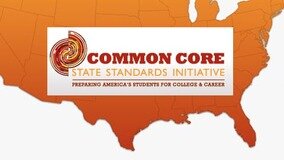Common Core State Standards Initiatives FAQs

What are the CCSS?
The CCSS are a state led effort by the National Governors Association and Council of Chief State School officers as a response to the need for clearer, fewer and higher national educational standards that prepare all students for college and the workforce.
Why CCSS? Why Now?
CCSS are necessary because of that statistics that demonstrate that although New York City public schools are graduating more students at the high school level, these students are not prepared to produce college level work. The adaptation of the CCSS will help ensure consistent expectations, regardless of a student’s zip code, ELL or Special Education status.
Where are the CCSS ELL standards?
There are no ELL specific standards. The expectation is that all students reach the rigorous expectations by using the standards as guideposts to address differentiation.
What are the key differences between NYS and CCSS?
Differences between NYS and CCSS Math
Differences between NYS and CCSS Literacy
What are the implications for my Quality Review for 2010-2011?
CCSS will be integrated into the2010-2011 Quality Review rubric in Quality Statement 5 “Monitor and Revise”. Schools will be expected to begin integrating CCSS expectations into planning around adjusting: curriculum, instruction, assessment, staff capacity building and organizational resources.
The CCSS implementations are a 4 year process. What are the Year 1 Requirements?
How are the standards organized?
English Language Arts
Comprehensive K-5 section
Two content-area specific sections for grades 6-1
ELA
Three Appendices
10 standards per grade level clustered under 4 bands that remain constant up through the grades
Math
Overview K-8:
HS Standards are listed in conceptual categories:
Standards for Mathematical Practice
The CCSS are a state led effort by the National Governors Association and Council of Chief State School officers as a response to the need for clearer, fewer and higher national educational standards that prepare all students for college and the workforce.
Why CCSS? Why Now?
CCSS are necessary because of that statistics that demonstrate that although New York City public schools are graduating more students at the high school level, these students are not prepared to produce college level work. The adaptation of the CCSS will help ensure consistent expectations, regardless of a student’s zip code, ELL or Special Education status.
Where are the CCSS ELL standards?
There are no ELL specific standards. The expectation is that all students reach the rigorous expectations by using the standards as guideposts to address differentiation.
What are the key differences between NYS and CCSS?
Differences between NYS and CCSS Math
- fewer topics , more generalizing and linking of concepts
- emphasis on both conceptual understand and procedural fluency since the early grades (not just getting the answer)
- some concepts are taught later
- focus on mastery of complex concepts in higher math via hands on learning
- emphasis on mathematical modeling in the upper grades
- standards increase in complexity from K-12 helping teachers find the gaps along the trajectory
Differences between NYS and CCSS Literacy
- literacy building as a shared responsibility for all content area teachers
- emphasis on teaching reading of informational text
- integration of research skills across the standards
- emphasis on writing to argue, inform, and explain in order to prepare for college
What are the implications for my Quality Review for 2010-2011?
CCSS will be integrated into the2010-2011 Quality Review rubric in Quality Statement 5 “Monitor and Revise”. Schools will be expected to begin integrating CCSS expectations into planning around adjusting: curriculum, instruction, assessment, staff capacity building and organizational resources.
The CCSS implementations are a 4 year process. What are the Year 1 Requirements?
- Curriculum: Schools engage in unwrapping and understanding the CCSS
- Pedagogy/Assessment: School teams begin to identify what adjustments in their curriculum and assessments need to be made in order to align instruction to the CCSS
- Collaboration: When setting school-wide goals teachers and administration begin to use the CCSS as a guide for anchoring various initiatives
- Structure: Schools should have a time for teacher teams to meet on a regular basis
How are the standards organized?
English Language Arts
Comprehensive K-5 section
- Reading Strand
- Speaking and Listening Strand
- Writing Strand
- Language Strand
Two content-area specific sections for grades 6-1
ELA
- Reading Strand
- Speaking and Listening Strand
- Writing Strand
- Language Strand
- Reading and Writing Strands
Three Appendices
- Appendix A: contains supplementary material on the strands
- Appendix B: contains texts and sample performance tasks
- Appendix C: contains student samples of student work
10 standards per grade level clustered under 4 bands that remain constant up through the grades
- Key ideas and details
- Craft and structure
- Integration of knowledge and ideas
- Range of Reading and Level of Text Complexity
Math
Overview K-8:
- K-5 standards provide students with a solid foundation in whole numbers, addition, subtraction, multiplication, division, fractions and decimals.
- 6-8 standards describe robust learning in geometry, algebra, and probability and statistics
HS Standards are listed in conceptual categories:
- Number and Quality
- Algebra
- Functions
- Modeling
- Geometry
- Statistics and Probability
Standards for Mathematical Practice
- Ensure that students who engage in these practices will discover ideas and gain insights that spur them to pursue mathematics beyond the classroom walls
